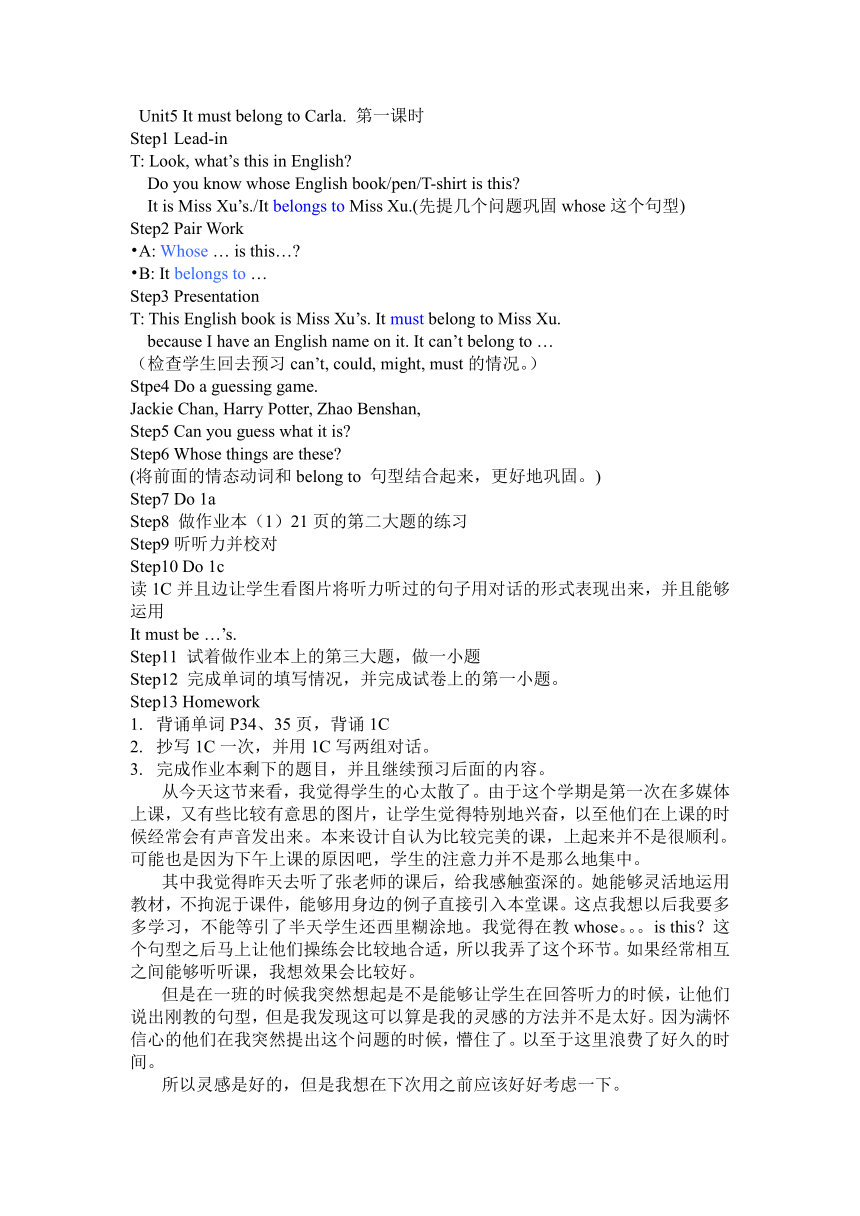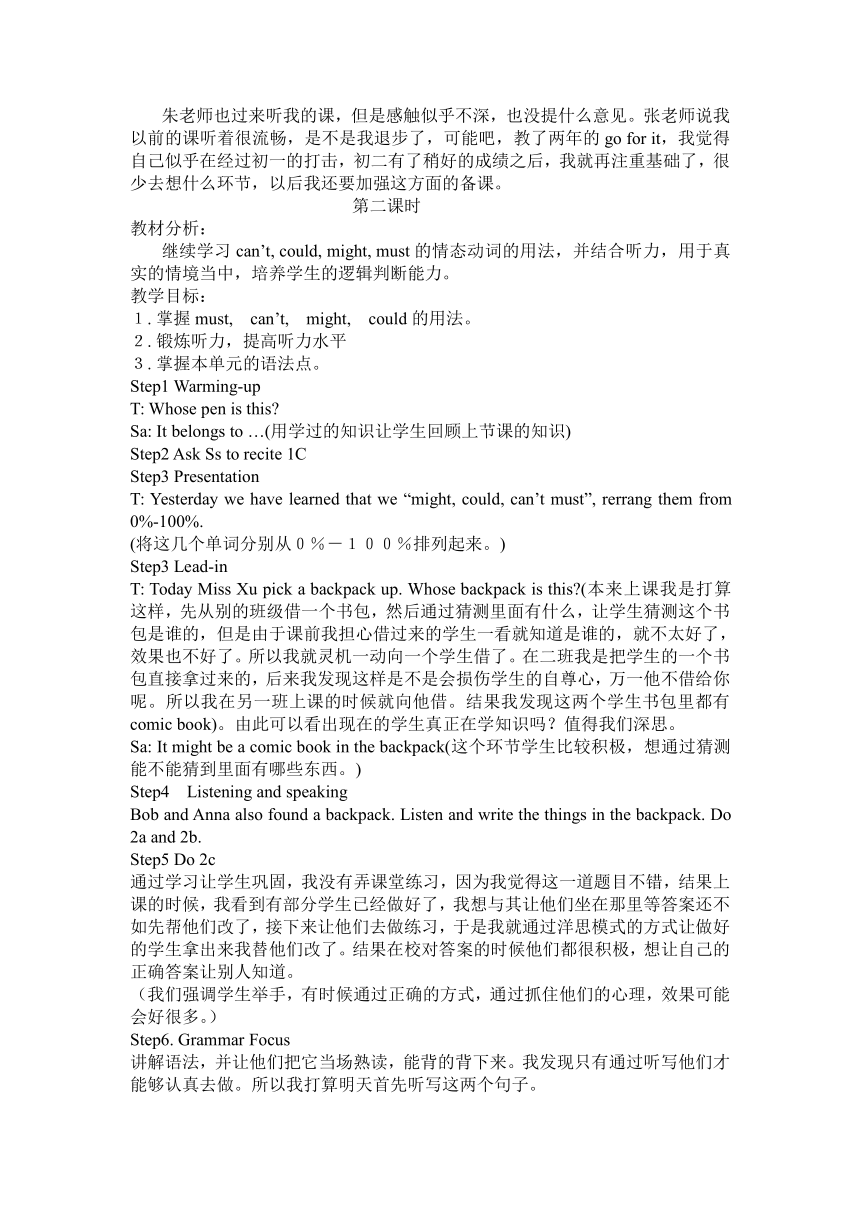Unit5 It must belong to Carla.[上学期]
文档属性
| 名称 | Unit5 It must belong to Carla.[上学期] |  | |
| 格式 | rar | ||
| 文件大小 | 11.3KB | ||
| 资源类型 | 教案 | ||
| 版本资源 | 人教新目标(Go for it)版 | ||
| 科目 | 英语 | ||
| 更新时间 | 2007-12-13 11:08:00 | ||
图片预览


文档简介
Unit5 It must belong to Carla. 第一课时
Step1 Lead-in
T: Look, what’s this in English
Do you know whose English book/pen/T-shirt is this
It is Miss Xu’s./It belongs to Miss Xu.(先提几个问题巩固whose这个句型)
Step2 Pair Work
A: Whose … is this…
B: It belongs to …
Step3 Presentation
T: This English book is Miss Xu’s. It must belong to Miss Xu.
because I have an English name on it. It can’t belong to …
(检查学生回去预习can’t, could, might, must的情况。)
Stpe4 Do a guessing game.
Jackie Chan, Harry Potter, Zhao Benshan,
Step5 Can you guess what it is
Step6 Whose things are these
(将前面的情态动词和belong to 句型结合起来,更好地巩固。)
Step7 Do 1a
Step8 做作业本(1)21 页的第二大题的练习
Step9听听力并校对
Step10 Do 1c
读1C并且边让学生看图片将听力听过的句子用对话的形式表现出来,并且能够运用
It must be …’s.
Step11 试着做作业本上的第三大题,做一小题
Step12 完成单词的填写情况,并完成试卷上的第一小题。
Step13 Homework
1. 背诵单词P34、35页,背诵1C
2. 抄写1C一次,并用1C写两组对话。
3. 完成作业本剩下的题目,并且继续预习后面的内容。
从今天这节来看,我觉得学生的心太散了。由于这个学期是第一次在多媒体上课,又有些比较有意思的图片,让学生觉得特别地兴奋,以至他们在上课的时候经常会有声音发出来。本来设计自认为比较完美的课,上起来并不是很顺利。可能也是因为下午上课的原因吧,学生的注意力并不是那么地集中。
其中我觉得昨天去听了张老师的课后,给我感触蛮深的。她能够灵活地运用教材,不拘泥于课件,能够用身边的例子直接引入本堂课。这点我想以后我要多多学习,不能等引了半天学生还西里糊涂地。我觉得在教whose。。。is this?这个句型之后马上让他们操练会比较地合适,所以我弄了这个环节。如果经常相互之间能够听听课,我想效果会比较好。
但是在一班的时候我突然想起是不是能够让学生在回答听力的时候,让他们说出刚教的句型,但是我发现这可以算是我的灵感的方法并不是太好。因为满怀信心的他们在我突然提出这个问题的时候,懵住了。以至于这里浪费了好久的时间。
所以灵感是好的,但是我想在下次用之前应该好好考虑一下。
朱老师也过来听我的课,但是感触似乎不深,也没提什么意见。张老师说我以前的课听着很流畅,是不是我退步了,可能吧,教了两年的go for it,我觉得自己似乎在经过初一的打击,初二有了稍好的成绩之后,我就再注重基础了,很少去想什么环节,以后我还要加强这方面的备课。
第二课时
教材分析:
继续学习can’t, could, might, must的情态动词的用法,并结合听力,用于真实的情境当中,培养学生的逻辑判断能力。
教学目标:
1. 掌握must, can’t, might, could的用法。
2. 锻炼听力,提高听力水平
3. 掌握本单元的语法点。
Step1 Warming-up
T: Whose pen is this
Sa: It belongs to …(用学过的知识让学生回顾上节课的知识)
Step2 Ask Ss to recite 1C
Step3 Presentation
T: Yesterday we have learned that we “might, could, can’t must”, rerrang them from 0%-100%.
(将这几个单词分别从0%-100%排列起来。)
Step3 Lead-in
T: Today Miss Xu pick a backpack up. Whose backpack is this (本来上课我是打算这样,先从别的班级借一个书包,然后通过猜测里面有什么,让学生猜测这个书包是谁的,但是由于课前我担心借过来的学生一看就知道是谁的,就不太好了,效果也不好了。所以我就灵机一动向一个学生借了。在二班我是把学生的一个书包直接拿过来的,后来我发现这样是不是会损伤学生的自尊心,万一他不借给你呢。所以我在另一班上课的时候就向他借。结果我发现这两个学生书包里都有comic book)。由此可以看出现在的学生真正在学知识吗?值得我们深思。
Sa: It might be a comic book in the backpack(这个环节学生比较积极,想通过猜测能不能猜到里面有哪些东西。)
Step4 Listening and speaking
Bob and Anna also found a backpack. Listen and write the things in the backpack. Do 2a and 2b.
Step5 Do 2c
通过学习让学生巩固,我没有弄课堂练习,因为我觉得这一道题目不错,结果上课的时候,我看到有部分学生已经做好了,我想与其让他们坐在那里等答案还不如先帮他们改了,接下来让他们去做练习,于是我就通过洋思模式的方式让做好的学生拿出来我替他们改了。结果在校对答案的时候他们都很积极,想让自己的正确答案让别人知道。
(我们强调学生举手,有时候通过正确的方式,通过抓住他们的心理,效果可能会好很多。)
Step6. Grammar Focus
讲解语法,并让他们把它当场熟读,能背的背下来。我发现只有通过听写他们才能够认真去做。所以我打算明天首先听写这两个句子。
Step7 做课堂练习的第一二课时
Step8 还有时间就做作业本上的作业,边做边分析。
Step9 布置家庭作业
我觉得这几天布置作业规范多了。
第三课时
教学目标:
熟练掌握情态动词must, might, could, can’t的用法,学会理解他们在句子中的含义。
Step1 听写前十个单词还有一个是Grammar Focus 的前两个句子
Step2 Warming-up
课前收集一些学生的语文书,数学书,ID card等东西,让学生猜测这些东西是谁的,并进行猜测:
Whose ID card is this It must/might/could/can’t be …’s/ belong to …
(通过前节课,我觉得这方法不错继续用)
Step3 Lead-in
T: Look at this picture, what is the girl doing
Do you know who is she (引出上节课听力书包的主人)
Ss: She is Linda, the backpack’s owner(引出新单词)
T: Do you know what is she doing
Sa: She might be play computer game. She could be writing an e mail to her friend.
T: Yes, she is writing, but not a email, but a thank-you message.
(让学生解释what is the thank-you message)
A thank-you letter must be a personal letter. In the letter the writer may express his gratitude for what the receiver has done for him/her.
Step4 Presentation
(1)阅读文章,并找到Linda wrote the email to whom
并让学生阅读句子,找出生词,并将生词画圈,根据上下文猜测含义。
生词:symphony, optometrist, appointment, algebra(where ) crucial, anxious
并将文章排序(按照意思)先不校对答案。
(2)讨论
用3b的对话:
What do you think“anxious”mean
I think it might mean “worried”. Because she can’t find her backpack.
(用讨论的方式让他们理解这些词语的意思)
(3)Explanation
1. If you have any idea where it might be, please call me.
If you have any idea … = If you know…
意思是: 如果你知道……
any用于if 引导的条件从句中, 有“若干的,有多少”的意思。
e. g. If you have any time, I’d like to talk with you.
2. I think I dropped it during the concerts so it might still be in the symphony hall.
用在已知的时期、节日或表示时间观念的名词前
e. g. during the summer, during my holidays, during our stay in Japan.
意思为: “当…之际”既可指某一动作在某个时期内连续不断的发生, 也可指某个动作在这一时期内的某一时间发生:
e. g. It snowed all day but stopped snowing during that night.
(并让学生提出还有哪些地方是不懂的)
(4)接着让学生再进行排列,在理解全文的基础上。
(5)再次让学生通过做练习巩固这些单词。(通过做课堂练习上的内容)
Step5 给他们一篇例文
Subject: Thanks! From: SusanDear Sandy,
When you left a package for me yesterday, I had difficulty waiting until my birthday to open it.
I don’t know how to thank you for such an attractive present. It is something that will give me pleasure for a long time to come.
Please accept my sincere thanks and best wishes.
Cordially,
Susan注(cordially =sincerely)
Step6 pair work
Sample conversations(4:P36)
1. — Here is a Chinese-English dictionary. It could belong to Mary. I know she has one.
— I don’t think so. It can’t be Mary’s. This one is new, but hers is old.
2. — Here is a flower. The owner must be a girl.
— Well, it could be a boy. The flower might be a present for his teacher
3—A: Here’s a school T-shirt. The owner must be a student.
B: Well, it could be a classmate of ours. The school T-shirt is the same as ours.
4—A: Here’s a hair band. The owner can’t be a boy.
—B: Well, it could be a boy. The hair band might be a present for his mother.
(ask Ss to make similar dialogue)
Homework
Fill in the blanks with must ,may, might, could, can’t
1.Whose earrings are these They _____ be Mary’s. she wears earrings sometimes.
2.Gina ______ come to the party tonight, but I’m not sure.
3.The telephone is ringing, but nobody answers it. He ______ be at home.
4.Is this Lan Qiang’s boxing glove Yes, it _____ be his. There is his name on the back.
5.You’d better take an umbrella. It ______ rain this afternoon.
Step1 Lead-in
T: Look, what’s this in English
Do you know whose English book/pen/T-shirt is this
It is Miss Xu’s./It belongs to Miss Xu.(先提几个问题巩固whose这个句型)
Step2 Pair Work
A: Whose … is this…
B: It belongs to …
Step3 Presentation
T: This English book is Miss Xu’s. It must belong to Miss Xu.
because I have an English name on it. It can’t belong to …
(检查学生回去预习can’t, could, might, must的情况。)
Stpe4 Do a guessing game.
Jackie Chan, Harry Potter, Zhao Benshan,
Step5 Can you guess what it is
Step6 Whose things are these
(将前面的情态动词和belong to 句型结合起来,更好地巩固。)
Step7 Do 1a
Step8 做作业本(1)21 页的第二大题的练习
Step9听听力并校对
Step10 Do 1c
读1C并且边让学生看图片将听力听过的句子用对话的形式表现出来,并且能够运用
It must be …’s.
Step11 试着做作业本上的第三大题,做一小题
Step12 完成单词的填写情况,并完成试卷上的第一小题。
Step13 Homework
1. 背诵单词P34、35页,背诵1C
2. 抄写1C一次,并用1C写两组对话。
3. 完成作业本剩下的题目,并且继续预习后面的内容。
从今天这节来看,我觉得学生的心太散了。由于这个学期是第一次在多媒体上课,又有些比较有意思的图片,让学生觉得特别地兴奋,以至他们在上课的时候经常会有声音发出来。本来设计自认为比较完美的课,上起来并不是很顺利。可能也是因为下午上课的原因吧,学生的注意力并不是那么地集中。
其中我觉得昨天去听了张老师的课后,给我感触蛮深的。她能够灵活地运用教材,不拘泥于课件,能够用身边的例子直接引入本堂课。这点我想以后我要多多学习,不能等引了半天学生还西里糊涂地。我觉得在教whose。。。is this?这个句型之后马上让他们操练会比较地合适,所以我弄了这个环节。如果经常相互之间能够听听课,我想效果会比较好。
但是在一班的时候我突然想起是不是能够让学生在回答听力的时候,让他们说出刚教的句型,但是我发现这可以算是我的灵感的方法并不是太好。因为满怀信心的他们在我突然提出这个问题的时候,懵住了。以至于这里浪费了好久的时间。
所以灵感是好的,但是我想在下次用之前应该好好考虑一下。
朱老师也过来听我的课,但是感触似乎不深,也没提什么意见。张老师说我以前的课听着很流畅,是不是我退步了,可能吧,教了两年的go for it,我觉得自己似乎在经过初一的打击,初二有了稍好的成绩之后,我就再注重基础了,很少去想什么环节,以后我还要加强这方面的备课。
第二课时
教材分析:
继续学习can’t, could, might, must的情态动词的用法,并结合听力,用于真实的情境当中,培养学生的逻辑判断能力。
教学目标:
1. 掌握must, can’t, might, could的用法。
2. 锻炼听力,提高听力水平
3. 掌握本单元的语法点。
Step1 Warming-up
T: Whose pen is this
Sa: It belongs to …(用学过的知识让学生回顾上节课的知识)
Step2 Ask Ss to recite 1C
Step3 Presentation
T: Yesterday we have learned that we “might, could, can’t must”, rerrang them from 0%-100%.
(将这几个单词分别从0%-100%排列起来。)
Step3 Lead-in
T: Today Miss Xu pick a backpack up. Whose backpack is this (本来上课我是打算这样,先从别的班级借一个书包,然后通过猜测里面有什么,让学生猜测这个书包是谁的,但是由于课前我担心借过来的学生一看就知道是谁的,就不太好了,效果也不好了。所以我就灵机一动向一个学生借了。在二班我是把学生的一个书包直接拿过来的,后来我发现这样是不是会损伤学生的自尊心,万一他不借给你呢。所以我在另一班上课的时候就向他借。结果我发现这两个学生书包里都有comic book)。由此可以看出现在的学生真正在学知识吗?值得我们深思。
Sa: It might be a comic book in the backpack(这个环节学生比较积极,想通过猜测能不能猜到里面有哪些东西。)
Step4 Listening and speaking
Bob and Anna also found a backpack. Listen and write the things in the backpack. Do 2a and 2b.
Step5 Do 2c
通过学习让学生巩固,我没有弄课堂练习,因为我觉得这一道题目不错,结果上课的时候,我看到有部分学生已经做好了,我想与其让他们坐在那里等答案还不如先帮他们改了,接下来让他们去做练习,于是我就通过洋思模式的方式让做好的学生拿出来我替他们改了。结果在校对答案的时候他们都很积极,想让自己的正确答案让别人知道。
(我们强调学生举手,有时候通过正确的方式,通过抓住他们的心理,效果可能会好很多。)
Step6. Grammar Focus
讲解语法,并让他们把它当场熟读,能背的背下来。我发现只有通过听写他们才能够认真去做。所以我打算明天首先听写这两个句子。
Step7 做课堂练习的第一二课时
Step8 还有时间就做作业本上的作业,边做边分析。
Step9 布置家庭作业
我觉得这几天布置作业规范多了。
第三课时
教学目标:
熟练掌握情态动词must, might, could, can’t的用法,学会理解他们在句子中的含义。
Step1 听写前十个单词还有一个是Grammar Focus 的前两个句子
Step2 Warming-up
课前收集一些学生的语文书,数学书,ID card等东西,让学生猜测这些东西是谁的,并进行猜测:
Whose ID card is this It must/might/could/can’t be …’s/ belong to …
(通过前节课,我觉得这方法不错继续用)
Step3 Lead-in
T: Look at this picture, what is the girl doing
Do you know who is she (引出上节课听力书包的主人)
Ss: She is Linda, the backpack’s owner(引出新单词)
T: Do you know what is she doing
Sa: She might be play computer game. She could be writing an e mail to her friend.
T: Yes, she is writing, but not a email, but a thank-you message.
(让学生解释what is the thank-you message)
A thank-you letter must be a personal letter. In the letter the writer may express his gratitude for what the receiver has done for him/her.
Step4 Presentation
(1)阅读文章,并找到Linda wrote the email to whom
并让学生阅读句子,找出生词,并将生词画圈,根据上下文猜测含义。
生词:symphony, optometrist, appointment, algebra(where ) crucial, anxious
并将文章排序(按照意思)先不校对答案。
(2)讨论
用3b的对话:
What do you think“anxious”mean
I think it might mean “worried”. Because she can’t find her backpack.
(用讨论的方式让他们理解这些词语的意思)
(3)Explanation
1. If you have any idea where it might be, please call me.
If you have any idea … = If you know…
意思是: 如果你知道……
any用于if 引导的条件从句中, 有“若干的,有多少”的意思。
e. g. If you have any time, I’d like to talk with you.
2. I think I dropped it during the concerts so it might still be in the symphony hall.
用在已知的时期、节日或表示时间观念的名词前
e. g. during the summer, during my holidays, during our stay in Japan.
意思为: “当…之际”既可指某一动作在某个时期内连续不断的发生, 也可指某个动作在这一时期内的某一时间发生:
e. g. It snowed all day but stopped snowing during that night.
(并让学生提出还有哪些地方是不懂的)
(4)接着让学生再进行排列,在理解全文的基础上。
(5)再次让学生通过做练习巩固这些单词。(通过做课堂练习上的内容)
Step5 给他们一篇例文
Subject: Thanks! From: SusanDear Sandy,
When you left a package for me yesterday, I had difficulty waiting until my birthday to open it.
I don’t know how to thank you for such an attractive present. It is something that will give me pleasure for a long time to come.
Please accept my sincere thanks and best wishes.
Cordially,
Susan注(cordially =sincerely)
Step6 pair work
Sample conversations(4:P36)
1. — Here is a Chinese-English dictionary. It could belong to Mary. I know she has one.
— I don’t think so. It can’t be Mary’s. This one is new, but hers is old.
2. — Here is a flower. The owner must be a girl.
— Well, it could be a boy. The flower might be a present for his teacher
3—A: Here’s a school T-shirt. The owner must be a student.
B: Well, it could be a classmate of ours. The school T-shirt is the same as ours.
4—A: Here’s a hair band. The owner can’t be a boy.
—B: Well, it could be a boy. The hair band might be a present for his mother.
(ask Ss to make similar dialogue)
Homework
Fill in the blanks with must ,may, might, could, can’t
1.Whose earrings are these They _____ be Mary’s. she wears earrings sometimes.
2.Gina ______ come to the party tonight, but I’m not sure.
3.The telephone is ringing, but nobody answers it. He ______ be at home.
4.Is this Lan Qiang’s boxing glove Yes, it _____ be his. There is his name on the back.
5.You’d better take an umbrella. It ______ rain this afternoon.
同课章节目录
- Unit 1 How can we become good learners.
- Section A
- Section B
- Unit 2 I think that mooncakes are delicious!
- Section A
- Section B
- Unit 3 Could you please tell me where the restroom
- Section A
- Section B
- Unit 4 I used to be afraid of the dark.
- Section A
- Section B
- Unit 5 What are the shirts made of?
- Section A
- Section B
- Review of Units 1-5
- Unit 6 When was it invented?
- Section A
- Section B
- Unit 7 Teenagers should be allowed to choose their
- Section A
- Section B
- Unit 8 It must belong to Carla.
- Section A
- Section B
- Unit 9 I like music that I can dance to.
- Section A
- Section B
- Unit 10 You're supposed to shake hands.
- Section A
- Section B
- Review of Units 6-10
- Unit 11 Sad movies make me cry.
- Section A
- Section B
- Unit 12 Life is full of the unexpected
- Section A
- Section B
- Unit 13 We're trying to save the earth!
- Section A
- Section B
- Unit 14 I remember meeting all of you in Grade 7.
- Section A
- Section B
- Review of Units 11-14
